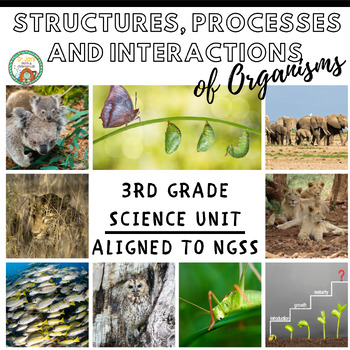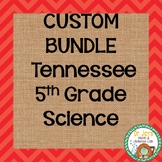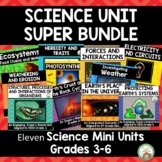3rd Grade Science: Structures, Processes, and Interactions of Organisms
- PDF
Also included in
- This is a custom bundle that includes all the units to address the 5th grade science standards for Tennessee.Price $86.72Original Price $108.40Save $21.68
- This bundle includes 11 units for teaching science all year long! We all struggle to find time to fit science in; use these quick and easy units to engage your students in a variety of science inquiries and activities. Aligned to current science standards. These units are appropriate for grades 3Price $84.64Original Price $105.80Save $21.16
- All 3 Units included in this bundle: Structures, Processes, and Interactions of Organisms, , Ecosystems, and Biomes. Buy all 3 together in this bundle and save. A variety of engaging activities included:Structures, Processes, and Interactions of OrganismsActivity 1: Life Cycles: Students work coPrice $21.28Original Price $26.60Save $5.32
- This bundle includes 6 hands-on science units aligned to the Next Generation Science Standards (NGSS) for 3rd grade. Each unit is packed full of inquiry-based activities, integrated language arts, word wall cards, games, task cards, projects, and assessments. Teacher pages, assessments, and answerPrice $52.16Original Price $65.20Save $13.04
- I decided to put this MEGA BUNDLE together because I have noticed that several buyers purchase multiple SCIENCE ENTIRE YEAR Super Bundles for different grade levels. I’m guessing these buyers are science teachers at the elementary level, homeschool parents with multiple levels of kids, or principalPrice $342.16Original Price $427.70Save $85.54
- This bundle includes a hands on inquiry unit as well as a PowerPoint to support the content and vocabulary of the unit. This product is aligned to 3rd Grade NGSS, but it is appropriate for grades 3-5.Included in the hands on unit:Activity 1: Life Cycles: Students work cooperatively to figure outPrice $13.28Original Price $16.60Save $3.32
- This product has everything you need to teach 3rd grade science. All activities and presentations are aligned to the Next Generation Science Standards (NGSS) for 3rd Grade. Included in this product are 6 hands on units that teach all of the NGSS standards for 3rd grade, as well a presentation (inPrice $69.12Original Price $86.40Save $17.28
- This Bundle includes 6 Units aligned to NGSS standards for 3rd Grade Science. This bundle includes both PDF Printable Files and the Google Classroom™ Digital Format. Presentations are also in Google Slides format and PowerPoint.This product gives teachers options to provide some activities in papePrice $119.36Original Price $149.20Save $29.84
Description
This unit engages students in inquiry-based activities to help them gain a conceptual understanding of life cycles, animals benefits from living in groups, adaptations and natural selection. Many opportunities for data collection and analysis are embedded in the mini unit allowing teachers to integrate math standards.
This Unit was designed to address these NGSS Science Standards for 3rd grade:
3-LS1-1. Develop models to describe that organisms have unique and diverse life cycles, but all have in common birth, growth, reproduction, and death.
3-LS2-1. Construct an argument that some animals form groups that help members survive.
3-LS4-2: Use evidence to construct an explanation for how the variations in characteristics among individuals of the same species may provide advantages in surviving, finding mates, and reproducing.
3-LS4-3: Construct an argument with evidence that in a particular habitat some organisms can survive well, some survive less well, and some cannot survive at all.
If you don't use NGSS, this unit is appropriate for grades 3-5
Activities Include:
Activity 1: Life Cycles: Students work cooperatively to figure out the life cycles of three different organisms.
Activity 2: Life Cycles Informational Reading and Questions
Activity 3: Animal Groups Poster Reports: Student research different animals and learn about the groups they live in. After their research, they organize a poster to share. An optional grading rubric is included as well as an extension activity about humans and groups.
Activity 4: Humans Live in Groups Writing activity
Activity 5: What Butterfly? Students examine environments and then create an insect that can camouflage well in the chosen environment. Class data is collected and analyzed.
Activity 6: Classifying Camouflage: This inquiry-based activity allows students to classify pictures and descriptions of animals based on the type of camouflage they use.
Activity 7: Butterfly Islands: In this activity students will simulate being birds and eating butterflies from different colored islands. Extensions to the idea of natural selection are made. Opportunities for data collection and analysis are included.
Activity 8: My Beak is Better Than Yours!: Students will test different “beaks” and their suitability for different food.
Word Wall Cards and Activities.
Post Test and Key
Please leave feedback (You can earn TpT credits for future purchases) and consider following my store! Thanks!
Do you teach 3rd grade and follow NGSS? This product is also available in a 3rd grade Entire Year Bundle covering all NGSS standards for 3rd grade. Check it out here:
Also available is the 3rd Grade Entire Year Super Bundle which also has Presentations to help solidify content and emphasize vocabulary.
*The Next Generation Science Standards (NGSS) is a registered trademark of WestEd. Neither WestEd nor the lead states and partners that developed the Next Generation Science Standards were involved in the production of this product, and do not endorse it.













